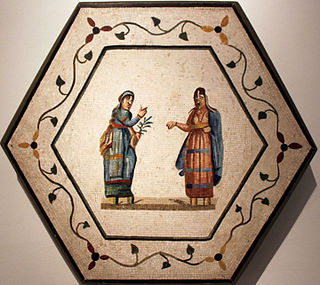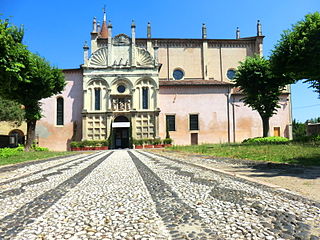
Torre del Greco is a comune in the Metropolitan City of Naples in Italy, with a population of c. 85,000 as of 2016. The locals are sometimes called Corallini because of the once plentiful coral in the nearby sea, and because the city has been a major producer of coral jewellery and cameo brooches since the seventeenth century.

Baiae was an ancient Roman town situated on the northwest shore of the Gulf of Naples and now in the comune of Bacoli. It was a fashionable resort for centuries in antiquity, particularly towards the end of the Roman Republic, when it was reckoned as superior to Capri, Pompeii, and Herculaneum by wealthy Romans, who built villas here from 100 BC. Ancient authors attest that many emperors built in Baia, almost in competition with their predecessors and they and their courts often stayed there. It was notorious for its hedonistic offerings and the attendant rumours of corruption and scandal.
Formia is a city and comune in the province of Latina, on the Mediterranean coast of Lazio, Italy. It is located halfway between Rome and Naples, and lies on the Roman-era Appian Way. It has a population of 38,095.

Piazza Armerina is a comune in the province of Enna of the autonomous island region of Sicily, southern Italy.

Lorium was an ancient village of ancient Etruria, Italy, on the Via Aurelia, 19 km west of Rome, near today's Castel di Guido.

Lonigo is a town and comune in the province of Vicenza, Veneto, northern Italy, its population counts around 16,400 inhabitants.

Giarratana is a town and comune in the province of Ragusa, Sicily, southern Italy. Its name is likely derived from Arabic.
Santa Caterina Albanese is an Arbëreshë village and comune in the province of Cosenza in the Calabria region of southern Italy.
Tarsia is a town and comune in the province of Cosenza in the Calabria region of southern Italy. The ancient town of Caprasia is thought to be the modern Tarsia.

Negrar di Valpolicella is a comune (municipality) in the Province of Verona in the Italian region Veneto, about 110 kilometres (68 mi) west of Venice and about 12 kilometres (7 mi) northwest of Verona. Since 8 February 2019, the official name has been changed to "Negrar di Valpolicella" after a referendum was held in the town.

Cupra Marittima is in the Province of Ascoli Piceno in the Italian region Marche, located about 70 km (43 mi) southeast of Ancona and about 30 km (19 mi) northeast of Ascoli Piceno.

Cottanello is a comune (municipality) in the Province of Rieti in the Italian region of Latium, located about 60 kilometres (37 mi) north of Rome and about 15 kilometres (9 mi) west of Rieti.
Vacone is a comune (municipality) in the Province of Rieti in the Italian region of Latium, located about 20 kilometres (12 mi) west of Rieti.
Casignana is a comune (municipality) in the Province of Reggio Calabria in region of Calabria, Italy and located about 35 km (22 mi) east of Reggio Calabria.

San Giorgio Morgeto is a comune (municipality) in the Province of Reggio Calabria in the Italian region Calabria, located about 70 kilometres southwest of Catanzaro and about 50 km (31 mi) northeast of Reggio Calabria. As of 31 December 2004, it had a population of 3,356 and an area of 35.1 square kilometres (13.6 sq mi).

Realmonte is a comune (municipality) in the Region of Agrigento in the Italian Provence Sicily, located about 90 kilometres (56 mi) south of Palermo and about 10 kilometres (6 mi) west of Agrigento.
The archaeological area of Poggio del Molino is situated on the northern side of a headland that acts as a watershed between the beach of Rimigliano in the north, and the Gulf of Baratti in the south; to the northern border of the territory administered by the city of Piombino in the Italian Province of Livorno. The structure of Roman age spreads over a high plateau of about 20 m asl which dominates, in the west, the stretch of a sea between San Vincenzo and Elba and to the east, the metalliferous hills and plains of the Campiglia lagoon. The top of the hill is occupied by the beautiful Villa del Barone, built in 1923 by Baron Luigi De Stefano and Assunta Vanni Desideri, the daughter of Eugenio. From a paper of the 16th century, the "Bandita di Porto Baratti", and some archival documents we know that the Poggio owes its name to the mill which was a part of Torre Nuova, the building of coastal defense and a lookout built in the early sixteenth century by Cosimo I de' Medici, on the slopes of the promontory.

The Villa Romana di Patti is a large and elaborate Roman villa located in the comune of Patti in the province of Messina on Sicily.

The extensive luxurious Roman villa Palazzi di Casignana is located on the seashore and near the ancient road linking ancient Locri and Rhegion in today's province of Calabria, Italy. It was discovered in 1964. It reached its zenith during the late empire of the 4th c. AD, a period of turbulence elsewhere.

















